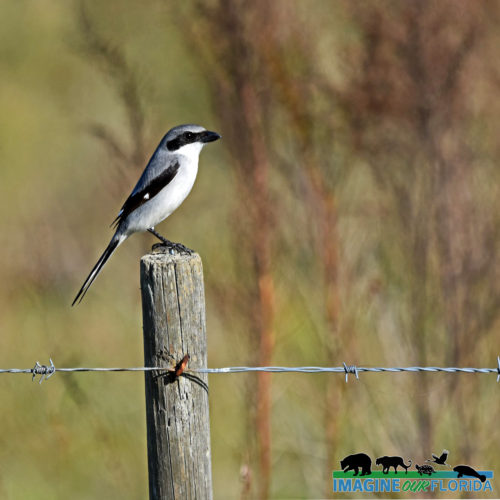Loggerhead Shrike
This small bird has a light gray body with a white underbelly. It has a black tail, wing markings, and a mask around its eyes (ECOS date unknown).
The species range extends as far north as Canada, along the prairies of the central region, down to Mexico. It can be found from the northern Gulf Coast to the southern part of Florida, where they spend the winter (FWC 2003).
Loggerheaded shrikes prefer areas with low vegetation, such as grasslands, marshes, prairies, scrubs, and sandhills. They can also be found near agricultural areas, golf courses, and urban areas. They can be found near structures with spines, such as barbed wire or thorns on plants (ECOS date unknown).
Most of their diet consists of insects such as grasshoppers and beetles. However, they consume larger prey such as mice, roadkill, and other birds. They attack the throat of their prey, paralyzing them before impaling them on spines before consuming them (ECOS date unknown).
Both sexes participate in nest selection sites, looking for thorny areas for protection. Females primarily construct the nest made of a stick foundation and lined with soft materials such as foliage and animal fur. About five eggs are laid with gray, brown, and black markings. They incubate for about 16 days, take two days to hatch, and begin leaving the nest at about 18 days and rely on their parents for food for up to 6 weeks (FWC 2003).
The spraying of sodium nitrate fertilizer has been shown to negatively affect populations. When sample nests were compared to control groups, there was a significant loss of eggs, nests, and offspring (Yosef and Deyrup, 2019).
References :
[ECOS] Environmental Conservation Online System. Date unknown. United States Fish and Wildlife Services. [Accessed 2023 March 19]: https://ecos.fws.gov/ecp/species/8833
[FWC] Florida Fish and Wildlife Conservation Commission. 2003. Florida’s breeding bird atlas: A collaborative study of Florida’s birdlife (Online). [Accessed 2023 March 19]: http://www.myfwc.com/bba/
Porter, C. 2000. “Lanius ludovicianus” (Online), Animal Diversity Web. [Accessed 2023 March 18] https://animaldiversity.org/accounts/Lanius_ludovicianus/
Yosef, R and Deyrup, MA. 2019. Effects of fertilizer-induced reduction of invertebrates on reproductive success of Loggerhead Shrikes (Lanius ludovicianus). Bulletin of Experimental Biology & Medicine. 166(6):307-312.

